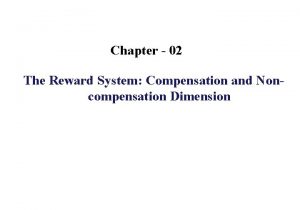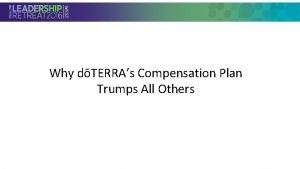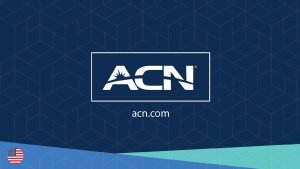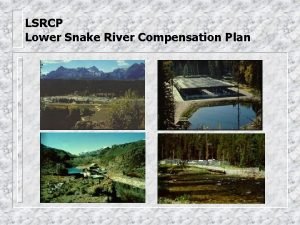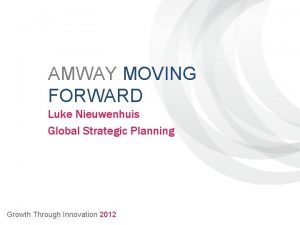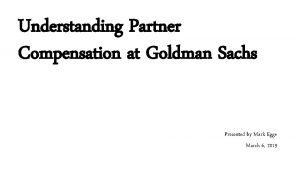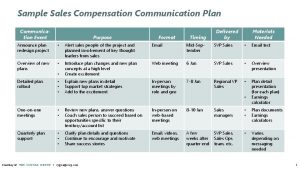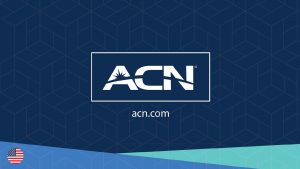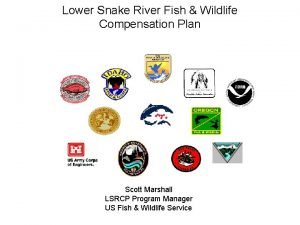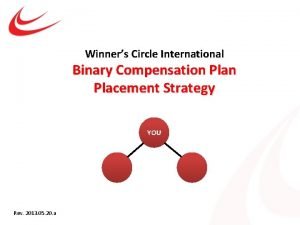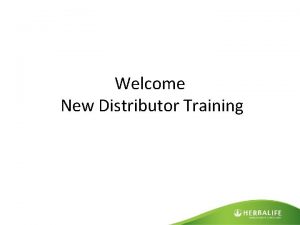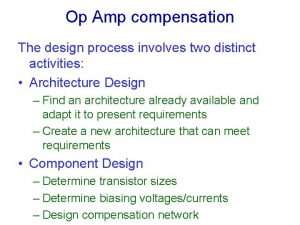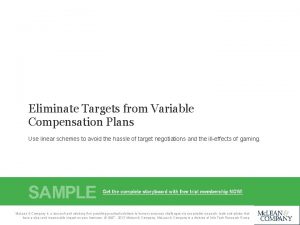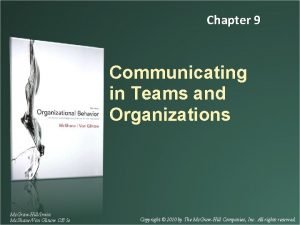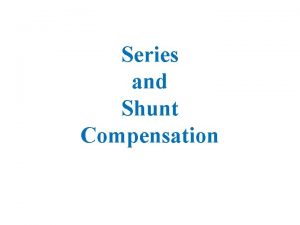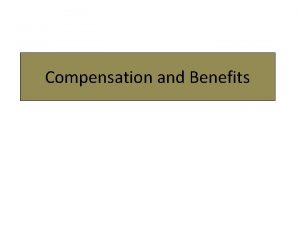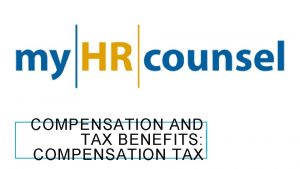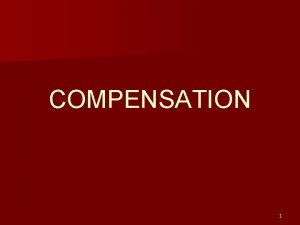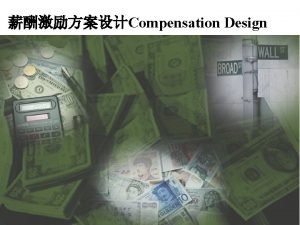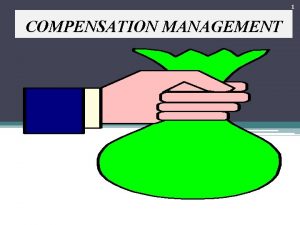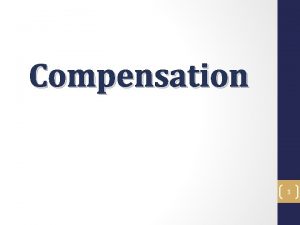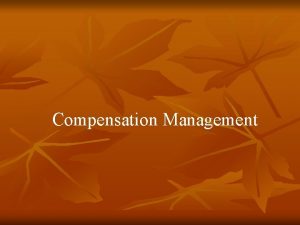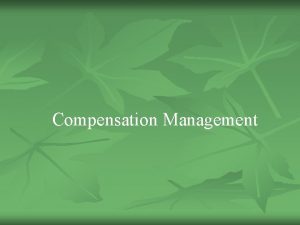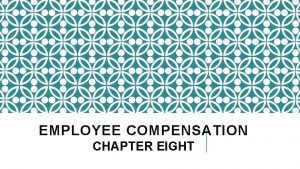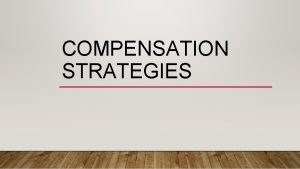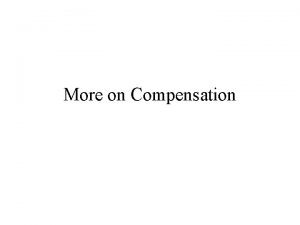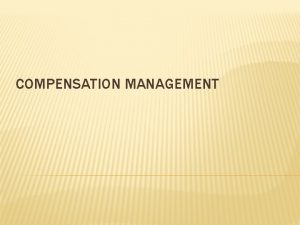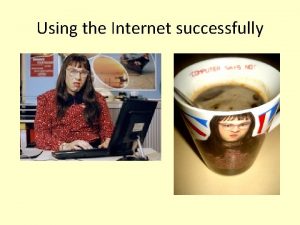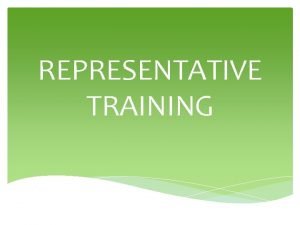Successfully Communicating and Implementing the Compensation Plan March











































- Slides: 43

Successfully Communicating and Implementing the Compensation Plan March 19, 2011 www. Sales. Globe. com www. The. Sales. Leadership. Forum. org 770 337 9897

A Bit About Us Mark Donnolo • Managing Partner. Sales. Globe and The Sales Leadership Forum • 20+ Years Sales and Marketing Effectiveness • Closet “Art School MBA” Advisory and Consulting Services -Sales Process Innovation -Sales Strategy -Customer Coverage -Sales Compensation -Sales Management Development www. Sales. Globe. com Page 2 © 2012 Sales. Globe Content, Coaching, Community -Sales Management -Sales Operations -Sales Compensation -Leading Business Schools www. The. Sales. Leadership. Forum. org Collette Parker • Director of Content & Communications, Sales. Globe • Extensive Sales Effectiveness and Sales Compensation Experience • Storyteller

2012 Calendar and Resources Visit: www. Sales. Globe. com/resources/events Also available for onsite briefings Sales Executive Track Sales Operations Track • Quarterly Executive Sessions – Atlanta, Dallas, London • Strategic Sales Compensation- Atlanta, Dallas, San Jose (July, August) • Customer Experience • Creative Quotient Developing Better Customer Solutions • Creative Quotient Becoming a More Effective Sales Leader Page 3 © 2012 Sales. Globe • Structuring Sales Ops • Quota Setting • Rapid Sales Comp Design

Resources Content and Research Forum Membership Sessions- In-Person and Virtual Coaching and Open Consulting Line Fast Cycle Research Member Match-Making on Key Issues at “Sales. Lead. Forum” www. The. Sales. Leadership. Forum. org www. Sales. Globe. com Page 4 © 2012 Sales. Globe

Overview • Context • Before You Start • The Why • Organization Views • Change Environment • The Process • Tools and Timing Page 5 © 2012 Sales. Globe

Incentive Compensation in Context High performing growth organizations plan, operate, and manage around four major competency areas and related disciplines. Sales programs must align between “upstream” and downstream disciplines. The Revenue Roadmap Insight Provides information for planning and strategy. Voice of the Customer Charts an actionable growth plan. Products and Services Macro Market Environment Competitor Performance Business Performance Sales Strategy Segmentation and Targeting Value Proposition Approach to Market Customer Coverage Matches roles, resources, and process to customer needs. Aligns execution with the growth strategy. Page 6 © 2012 Sales. Globe Sales Channels Sales Roles and Structure Sales Process Sales Deployment Enablement Incentive Comp and Quotas Recruiting and Retention Training and Development Account Planning

Optimizing Incentive Compensation Effective incentive compensation design follows a proven evaluation and development process. Quotas create a critical link between performance and pay. Sales Compensation Design Process SM Total target compensation levels that consider market rates and internal company value. Target Pay Ongoing program management, performance evaluation, and planning. Policies and process to manage program operations according to the design. 2 Operations & Evaluation Pay Mix 9 3 1 8 Measures & Priorities 7 5 Mechanics 6 Page 7 © 2012 Sales. Globe 4 Objectives & Quotas *Please read “ 10 Simple Rules for Improving Your Sales Compensation Plan” for further information. Incentive for top performers and plan entry points that differentiate for achievement. Upside & Threshold Sales Roles Governance Market-based quotas, equitably set to enable greater overall organization performance. Salary and incentive ratios that reflect the sales role and sales environment. Performance metrics and weights that clearly communicate business priorities. Specifications that link pay to performance across all attainment levels.

Before You Start Have You… o o Page 8 Tested your plan design with management or reps? Financially modeled to know the possibilities, winners, and losers? Enlisted opinion leaders? Developed a plan to implement and communicate? © 2012 Sales. Globe

The Why Page 9 © 2012 Sales. Globe

What’s Your Change Story? Why are we changing the Sales Comp Plan? 4 A future opportunity for growth? 4 Align with a new coverage model? 4 Support our strategic goals? 4 Stem turnover? Page 10 © 2012 Sales. Globe

What’s the Right Motivator for Change? Motivators of Change Message: “Someday, move if Message: “If“If wewe don’t move we now, we can this take strategy now, follow some of us will be (and advantage comp of plan), ajobs lucrative we’ll looking for new this time dominate avoid opportunity being the beaten for market. ” the by next year. ” the niche and company competitors. ” employees. ” Near-Term 1. Alleviate Pain 2. Capture Opportunity 3. Reduce Risk 4. Pursue Vision Avoid Pain Gain Benefit Time Long-Term Opportunity Page 11 © 2012 Sales. Globe Response: “You’re “I’ll “I’m Response: “I’m onbe board. dreaming. retired listening. It Why may take the What doby wethen. ” need tobe do? ” risk? ” the change. ” worth

The “Why” Comes From Management Sales programs should support the organization’s strategic priorities for the organization. Articulating the CLevel Goals provides clear direction for the compensation program. om Pr o du ct/ Of Coverage/Roles Talent Role rage / nt Tale C-Level Goal Dimensions s fer Financial q Reach $5 B by 2015 and Gain Greater Productivity from Existing Resources “We want to drive 2 x more productivity from the sales organization 3 years from now. ” q Develop Management Roles, Distinct from Production “Managers need to leverage their teams rather than being big sales people. ” Cove t us C er Financial q Drive a Sales-Oriented Culture “We need to break the complacency in the organization. We have a cultural issue. ” q Attract Future Talent “We can’t hire the right talent and should consider the future sales person. ” Customer q Develop More Strategic Customer Relationships “We’re still selling to the middle of the customer organization and doing transactional deals. ” Product/Offer q Promote Cross-Selling of Our Portfolio “Our strategy is about offering our full portfolio of solutions to the customer. ” Page 12 © 2012 Sales. Globe

The Change Story The change story is the first incarnation of the key messages and themes. It includes: 4 What the change is (sales comp, sales channels, job roles, merger, etc. ). 4 Who will be affected (the sales organization, major accounts, one region, etc. ). 4 When the change will take place (and the length of the process). 4 Why the change is necessary now, as opposed to the past or future. Page 13 © 2012 Sales. Globe

Organization Views Page 14 © 2012 Sales. Globe

Some Assumptions It is human nature to assume change will be negative. Changes to the compensation are seen as a company ploy to manage pay or save money. Changes to quotas are not seen as equitable. Open communication throughout the process, before and during implementation, can resolve these fears. Page 15 © 2012 Sales. Globe

Where Are Your Resistance Points? Behaviors • Confused understanding Passive • Slow to act • Non compliance Aggressive • Outright opposition • Finding issues • Demonstrating poor results Typically, you can expect: 420% will accept the new plan without argument. 450% will wait and see, but will eventually come around. 430% will actively object to the new plan or try to sabotage it. Page 16 © 2012 Sales. Globe

Change Environment Page 17 © 2012 Sales. Globe

Change Environment. The Key Questions 1. What degree of change? (1 minor-10 major) On a scale from minor adjustment to major strategic change, what degree of change will this be for the organization? Page 18 © 2012 Sales. Globe

Change Environment. The Key Questions 2. When was the last time? (1 recently-10 never) When was the last time the organization implemented a change to the sales compensation plan? The longer the current plan has been in place the more resistant the organization may be to change. Page 19 © 2012 Sales. Globe

Change Environment. The Key Questions 3. What’s the organization’s tolerance? (1 high-10 low) Is the organization change averse or change embracing? Page 20 © 2012 Sales. Globe

Change Environment. The Key Questions 4. What’s your management team’s tolerance? (1 high-10 low) How important is it to make this change? At what cost? What level of breakage are you willing to sustain? q “We need to move this organization to a true sales culture and kill the environment of entitlement. ” q “We need to take care of the team. The VP of Sales calls the organization his “kids”. Page 21 © 2012 Sales. Globe

Change Environment. Summing It Up 1. What degree of change? (1 minor-10 major) 7 2. When was the last time? (1 recently-10 never) 4 3. What’s the organization’s tolerance? (1 high-10 low) 4 4. What’s your management team’s tolerance? (1 high-10 low) 8 ___ 23 moderate Score of: 1 -10: Smooth Sailing- Use normal modes of communications and management. 11 -20: Choppy Seas- Carefully plan, enhance clarity, test responses. 21 -30: Gale Winds- Use multiple communication modes, close change management. 31 -40: Potential Storm- Brace for change, strong leadership messages, change management, potential “hammer”. Page 22 © 2012 Sales. Globe

The Process Page 23 © 2012 Sales. Globe

The Process The very first step is to define success: 4 Define business success for the sales compensation program (in revenue, units sold, etc. ) 4 Define success for the implementation of the new plan (by understanding, uptake, behaviors, etc. ) Page 24 © 2012 Sales. Globe

The Process The next step is to assess the company’s past approach to change. 4 Water cooler? 4 Email blasts from leadership or managers? 4 Social media like Twitter or blogs? 4 In person meetings (large group or small)? Based on your Change Environment score (1 -40), is your past approach up for the current challenge? Page 25 © 2012 Sales. Globe

The Process The approach should include: Outbound Communication Messages from the leadership and managers. Organization (Sales, Service, Ops, etc. ) Inbound Communication Hotlines and other methods of communication for the front line (and the entire organization) to ask questions, voice concerns, and receive rapid feedback. Page 26 © 2012 Sales. Globe

Communications- Not Just for Implementation A good approach considers communication beyond Implementation… during the Assessment Phase and the Design Phase. Page 27 © 2012 Sales. Globe

Addressing Learning Modes Consider using a variety of communications methods that align with learning modes*. For Implementing the Plan 1. Linguistic: Have rich vocabulary and Use Verbal Messages and Conversations- Group or Individual 2. Logical-Mathematical: Have ability Use Plan Calculators and Examples and Be Clear on Comparisons to Prior Plan sensitivity to the meaning of words, Learn through language, both in writing and orally. Successful learners by listening and hearing, and through telling stories. Sort the information through their listening and repeating skills. to see relationships between objects and solve problems, as in calculus and engineering. Use numbers wisely and enjoy solving problems. They have the ability to understand logical patterns, categories and relationships, causes and effects. *Howard Gardner’s Multiple Intelligence Theory Page 28 © 2012 Sales. Globe

Addressing Learning Modes For Implementing the Plan 3. Visual: High visual intelligence Use Visual Models 4. Kinesthetic: Learning through touch, Use Demonstrations or Role Plays 5. Musical: Recognize tones, rhythms Use Messaging and Phrases to Reinforce. “ 55 to Stay Alive” translating information into images and pictures. manipulating, and movement. Activities, games, acting, hands-on tasks, building. and musical patterns. Can remember and repeat a melody after listening it to once. Page 29 © 2012 Sales. Globe

Addressing Learning Modes For Implementing the Plan 6. Interpersonal: Understand Use Messages About the Organization, Conversations, and Enlist as Supporters 7. Intrapersonal: Use Messages About Personal Growth and Allow Time to Absorb Before Follow-Up care about people and their feelings, and interact effectively with them. Have the ability to influence people and are natural leaders. Ability to think about and understand one's self. Aware of their strengths and weaknesses, moods and motivations. They have the ability for self discipline to achieve personal goals. Prefer to study individually. Page 30 © 2012 Sales. Globe

Tools and Timing Page 31 © 2012 Sales. Globe

Some Key Tools for Assessment and Design A good approach considers communication beyond Implementation… during the Assessment Phase and the Design Phase. Page 32 © 2012 Sales. Globe

Tools During Assessment and Design Leverage some important tools during Assessment and Design: 4 CEO Announcement 4 Consistent Interview Guides 4 Sales Force Survey 4 Progress Presentations Example 47% of Sales believes the plan is very to moderately easy to understand. 37% of Support believes the plan is very to moderately easy to understand. Comparable average: 49% Only 11% of Sales compared to 36% of Support finds the plan not easy to understand or complicated. Page 33 © 2012 Sales. Globe

Some Key Tools for Implementation A good approach considers communication beyond Implementation… during the Assessment Phase and the Design Phase. Page 34 © 2012 Sales. Globe

Tools During Implementation Have documents and tools in place prior to implementation: 4 Management Key Message Points and Scripts: To maintain the consistency of the earlier message (Assessment Phase)and to make sure all managers have the same message. 4 FAQs: Answers to anticipated questions to pre-think and build consistency. 4 Plan Documents: Detailed descriptions of all plan facets. 4 Key components: objectives, overview, details, examples, policies, sign off. 4 Plan Calculators: Simple rep tools to illustrate payouts based on various performance scenarios. 4 Web-Based Performance Tracking: Online tools for enhanced communications and incentive administration. Page 35 © 2012 Sales. Globe

A Cascading Delivery Method Day One: Plan Announcement Page 36 © 2012 Sales. Globe 1 -2 Weeks After Announcement: Initial Assessment of Adoption 30 -60 -90 Days: Ongoing Assessment of Understanding and Adoption

Cascading Communications- Executive Level Pre-Launch Assuage the Affected • Before presentation to the organization, address valued players affected by the new plan or the overall change. • One-on-one meetings, at least one week prior to announcement, to explain the change and how they can be successful under the new plan. Day One Deliver C-Level Strategic Vision and Key Themes • C-Level (or appropriate executive) delivers an introduction and overview of the new plan. Gives the overall strategic vision of the company and the reasons the changes need to be made now. • May be delivered in a combination of live in-person, pre-recorded web message, email. Use methods most consistent with the culture of the company and the change environment. Page 37 © 2012 Sales. Globe

Cascading Communications- Management Level Day Two Reinforce Strategic Themes at the Team Level • Articulate regional and team priorities including roles and changes. • Describe plan details, account assignments, and goals. Goals may also be introduced following the close of the fiscal year. • Typically regional and small group breakouts. Page 38 © 2012 Sales. Globe

Cascading Communications- Immediate Follow-Up Inbound Communications Tools • Set up to quickly address questions and concerns. • 800 Hotline, dedicated e-mail address, company-operated blog. • Warning: Without these vehicles, sales reps will sometimes turn to their own external methods of communication, taking control of the message. Page 39 © 2012 Sales. Globe

Cascading Communications- Staged Evaluation 7 -14 Days Following Implementation • Managers readily available to answer questions and address concerns. • Managers proactively reach out to direct reports to confirm understanding and check for acceptance or resistance to the plan. 30 Days Following Implementation • Managers and leadership check for an understanding of the new plan through a management huddle and a mini-survey. Page 40 © 2012 Sales. Globe

Cascading Communications- Staged Evaluation 60 Days Following Implementation • Managers and leadership check for changes in behaviors consistent with the goals of the new plan through metrics and a management huddle. 90 Days Following Implementation • Managers and leadership check for results indicating the new plan is working. Make adjustments in the plan as necessary. Monthly or Quarterly Following Implementation • Conduct periodic evaluation of plan performance, metrics, organization, and connection to strategic performance. • Prepare for next annual plan design cycle. Page 41 © 2012 Sales. Globe

5 Points to Remember 1. Have a plan and a clear message before you roll-out. 2. Understand your change environment, and your tolerance for change. 3. Use multiple modes of communication and a cascading, methodical process. 4. Stay connected to the organization. 5. Get professional help to do it right the first time. Page 42 © 2012 Sales. Globe

Thank You Available to Webinar Participants: Session Materials and Content Available to TSLF Members Includes: The Rapid Sales Comp Diagnostic “Answers and Actions in 2 Weeks” -Technical Alignment -Strategic Alignment -Coverage Alignment -Key Issues -Recommended Actions -One Sales Group (Up to three role types) Two week duration with report and readout. To schedule, contact Eileen at (770) 337 -9897 or EGold@salesglobe. com Questions and Counsel: Mark Donnolo- MDonnolo@Sales. Globe. com Collette Parker- CParker@Sales. Globe. com Page 43 © 2012 Sales. Globe
 Silk glove sign
Silk glove sign Noncompensation
Noncompensation Anthem of poland
Anthem of poland Platinum ambassador herbalife salary
Platinum ambassador herbalife salary Shaklee global conference 2021
Shaklee global conference 2021 Acn payment plan
Acn payment plan Lower snake river compensation plan
Lower snake river compensation plan Louisiana dcp
Louisiana dcp Longrich investment plan
Longrich investment plan Financial education services compensation plan
Financial education services compensation plan Enagic comp plan
Enagic comp plan Primerica comp plan
Primerica comp plan Amway strategic plan
Amway strategic plan Acninc com
Acninc com Goldman sachs partner salary
Goldman sachs partner salary Example compensation communication plan
Example compensation communication plan Fm compensation plan
Fm compensation plan Nu skin compensation plan
Nu skin compensation plan Acn compensation plan
Acn compensation plan Lower snake river compensation plan
Lower snake river compensation plan What is 100 pv in amway
What is 100 pv in amway Winners circle international
Winners circle international Prepaid legal services oklahoma
Prepaid legal services oklahoma Alan noble asea
Alan noble asea New distributor training
New distributor training Zilis catalog
Zilis catalog Pole splitting miller compensation
Pole splitting miller compensation Longrich compensation plan
Longrich compensation plan Legalshield compensation plan
Legalshield compensation plan Compensation plan
Compensation plan Linear compensation plan
Linear compensation plan Louisiana deferred compensation
Louisiana deferred compensation Level compensation plan
Level compensation plan Implementing strategies management and operations issues
Implementing strategies management and operations issues Strategy implementation example
Strategy implementation example Chapter 7 strategic management
Chapter 7 strategic management Tripod of pricing
Tripod of pricing Designing and implementing brand marketing programs
Designing and implementing brand marketing programs Designing and implementing branding strategies
Designing and implementing branding strategies Crm project design and planning process
Crm project design and planning process Implementing strategies management and operations issues
Implementing strategies management and operations issues Nivea brand architecture
Nivea brand architecture Implementing strategies management and operations issues
Implementing strategies management and operations issues Communicating in teams and organizations
Communicating in teams and organizations

